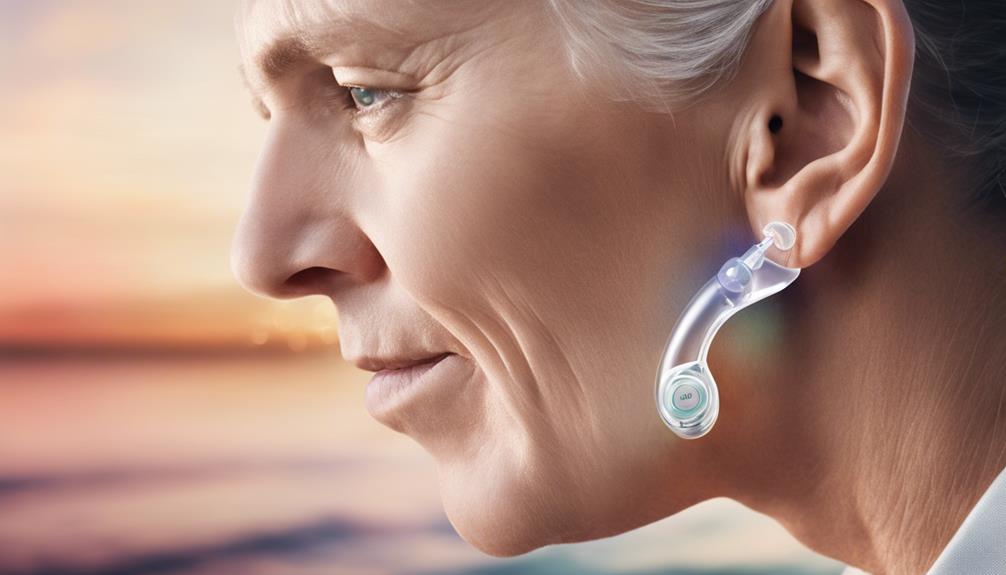Have you explored all the amazing features that the latest Hear Now hearing aids offer?
From unparalleled speech clarity in bustling environments to seamless Bluetooth connectivity, these devices are revolutionizing the way we experience sound.
But what sets them apart from the rest? Let's uncover the details that make these hearing aids a game-changer for individuals seeking a superior listening experience.
Key Takeaways
- Incorporation of advanced technologies for enhanced hearing experiences
- Seamless Bluetooth connectivity for wireless audio streaming
- Rechargeable options with advanced lithium-ion batteries
- Customizable solutions for individual comfort and performance
Latest Features of Hear Now Aids
The latest features of Hear Now aids incorporate advanced technologies tailored to enhance the hearing experiences of users. With Bluetooth connectivity, these hearing aids allow for seamless wireless audio transmission from Bluetooth-enabled devices, offering greater versatility and convenience. Additionally, Hear Now aids feature feedback cancellation technology, effectively eliminating shrill noises and preserving authentic sound quality for a more natural listening experience.
Moreover, the inclusion of tinnitus masking capability in Hear Now aids is a significant benefit for individuals experiencing tinnitus. By producing low-level white noise, this feature helps reduce the disturbance caused by tinnitus, promoting a more tranquil auditory environment. Furthermore, the integration of Digital Signal Processing (DSP) in Hear Now aids plays a vital role in distinguishing verbal communication from background noises, resulting in enhanced clarity and comprehension for the wearer.
Compatibility With Mobile Devices

Integrating Bluetooth connectivity, Hear Now hearing aids seamlessly sync with mobile devices for enhanced audio streaming capabilities. This feature not only enhances sound quality but also provides a cord-free experience for users, eliminating the hassle of dealing with wires. Direct audio transmission to the ear canal from the hearing aid speaker ensures clear and crisp sound for the wearer. The compatibility with mobile devices allows for seamless integration with smartphones and tablets, offering users the convenience of hands-free phone calls and direct music streaming to their hearing aids.
3 Ways Hear Now Hearing Aids Enhance Your Mobile Experience:
- Hands-Free Convenience: With Bluetooth connectivity, users can effortlessly make hands-free phone calls, improving accessibility and safety while on the go.
- Wireless Audio Streaming: Enjoy seamless wireless audio streaming from mobile devices, ensuring a hassle-free and enjoyable listening experience.
- Direct Sound Transmission: Experience clear and direct sound transmission to the ear canal from the hearing aid speaker, enhancing the overall audio quality for users.
Rechargeable Options Available
Offering users a convenient and eco-friendly solution, Hear Now provides rechargeable hearing aids with advanced lithium-ion batteries. These rechargeable options not only offer a cost-effective alternative to traditional disposable batteries but also contribute to a sustainable environment. With portable charging cases designed for on-the-go lifestyles and models featuring wireless charging capabilities, users can enjoy uninterrupted usage and added convenience.
To highlight the benefits of Hear Now's rechargeable hearing aids, we present a comparison table below:
| Features | Benefits |
|---|---|
| Lithium-ion batteries | Longer battery life, reduced need for replacements |
| Portable charging cases | Convenient charging on the move, ensuring continuous usage |
| Wireless charging | Effortless charging experience, no need for cumbersome cables |
| Cost-effective solution | Savings over time compared to purchasing disposable batteries |
| Eco-friendly option | Reduced environmental impact by minimizing battery waste and disposal issues |
Experience the freedom of superior listening experiences without the inconvenience of traditional battery changes with Hear Now's rechargeable hearing aids.
Advanced Sound Clarity Technology

Utilizing cutting-edge sound clarity technology, Hear Now's latest hearing aids deliver unparalleled speech understanding in challenging auditory environments. These advanced devices are equipped with dual processor technology, ensuring natural, detailed, and clear sound quality for users.
The incorporation of Bluetooth connectivity allows seamless wireless audio transmission from Bluetooth-enabled devices, enhancing the overall listening experience. Moreover, the convenience of rechargeable batteries in Hear Now hearing aids caters to the on-the-go lifestyles of individuals, providing portability and ease of use.
3 Ways Hear Now's Advanced Sound Clarity Technology Enhances Your Listening Experience:
- Immersive Sound Quality: Experience a new level of clarity and precision in speech understanding, even in noisy surroundings, thanks to the innovative sound clarity technology.
- Seamless Connectivity: Stay effortlessly connected to your favorite devices through Bluetooth connectivity, ensuring a seamless and enjoyable listening experience without any hassle.
- Convenience Redefined: With rechargeable batteries, Hear Now hearing aids offer unparalleled convenience, eliminating the need for frequent battery changes and providing a more sustainable solution for daily use.
Customizable Options for Individual Needs
For individuals seeking personalized solutions to meet their unique hearing needs, Hear Now provides a range of customizable options tailored for optimal comfort and performance. These customizable options cater to various styles, sizes, and features to ensure specific hearing requirements and preferences are met.
With personalized fit options such as rechargeable battery power, convenience and long-lasting use are prioritized in the design. Connectivity to all devices is seamlessly integrated, enhancing accessibility in daily activities.
Hear Now also offers discreet or stylish preferences through innovative designs that reflect personal style while incorporating advanced technology for complex hearing situations. By prioritizing customizable options, Hear Now ensures that individuals receive tailored solutions that not only address their hearing care needs but also provide the connectivity and advanced technology required for a comprehensive and effective hearing aid experience.
Frequently Asked Questions
Which Is the Latest Hearing Aid?
The latest hearing aid is the IX model with dual processor technology for improved speech clarity in noisy settings. It's designed for active, younger individuals, offering a nearly invisible look, advanced features, and rechargeable capabilities.
The IX model uses two processors to enhance speech contrast against background noise, delivering a natural sound experience. With Bluetooth connectivity and a rechargeable option, this hearing aid ensures exceptional listening experiences for all activities.
What to Know Now That Hearing Aids Are Available Over the Counter?
When hearing aids are available over the counter, it's essential to understand the potential benefits and limitations. Knowing the level of hearing loss and seeking guidance from a healthcare professional can ensure that the right device is chosen.
Regular check-ins and adjustments may be necessary for optimal performance. Being informed about the features, warranties, and return policies of OTC hearing aids can help make a well-informed decision about managing hearing loss effectively.
What Are the New Hearing Aids for 2024?
In 2024, the new hearing aids bring dual processor technology, Bluetooth connectivity, and a rechargeable feature, making them ideal for active, younger users seeking improved speech clarity and reduced background noise.
These nearly invisible aids cater to various lifestyle needs, offering Speech Focus technology for clear communication in any setting.
With innovative design, connectivity to all devices, and personalized fit options, these hearing aids prioritize convenience and accessibility for all users.
What Are the Top Five Rated Hearing Aids?
We've discovered the top five rated hearing aids, including:
- Signia Pure Charge&Go X
- Phonak Paradise
- Widex Moment
- Oticon More
- ReSound ONE
Each model offers unique features like rechargeable batteries, excellent sound quality, natural sound, BrainHearing technology, and personalized fitting.
These aids cater to diverse needs with advanced technology and connectivity options.
It's essential to choose the right one based on individual preferences and requirements for an optimal hearing experience.
Conclusion
In conclusion, the latest Hear Now hearing aids offer a plethora of innovative features that cater to individual needs and preferences. From dual processor technology for enhanced speech understanding to Bluetooth connectivity for seamless wireless audio transmission, these devices provide advanced sound clarity and convenience.
With customizable options and rechargeable batteries, users can enjoy a personalized listening experience. Elevate your hearing experience with the cutting-edge technology of Hear Now aids, designed to enhance your everyday life with clarity and comfort.











